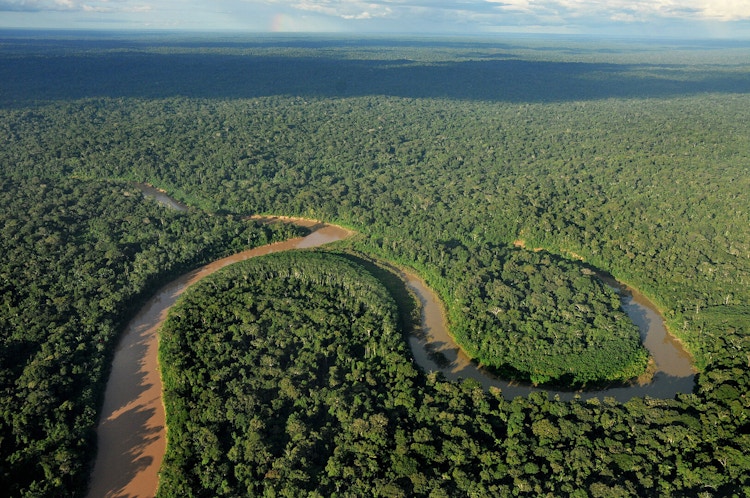Only a third of the tropical rainforest remains intact
The world’s first complete historical and current overview reveals that two thirds of the tropical rainforest on Earth are gone or degraded.

Large continous areas of rainforests are under increasing pressure. This picture was taken in Peru in 2012. Photo: Wolter Silvera
Rainforest Foundation Norway launches the unique State of the Tropical Rainforest Report at the beginning of a significant year for environmental protection, with the UN biodiversity and climate change summits providing opportunities for accelerated global efforts.
“We now know how much tropical rainforest that is left in the world and the state it is in, and we have compared this to estimates of how much tropical rainforest that existed before modern human interference. This knowledge is essential for the upscaling of the global fight to save what is left. It is alarming that nearly half of the world’s rainforests are degraded, ” says Anders Krogh.
Krogh is the author of the new report and works as a special advisor at Rainforest Foundation Norway. Krogh has analysed and compiled Global Forest Watch data from all of the 73 countries that are home to the world’s tropical rainforests, the planet’s oldest and most diverse terrestrial ecosystem. His findings are as bleak as they are unique.

The top diagrams refer to original rainforest cover, while the bottom one refers to current rainforest cover.
Of the approximately 14.5 million square kilometres of tropical rainforest that once covered Earth’s surface, only 36 % remains intact. Just over a third, 34 %, is completely gone and the last 30 % is in various forms of degradation.
Of the current rainforest cover, almost half (45 %) is in a degraded state.
“The good news is that we have an area half the size of Europe that is still completely intact. However, the remaining tropical rainforests are either severely damaged or increasingly fragmented. Humans are chopping these once vast and impenetrable forests into smaller and smaller pieces, undermining their ability to store carbon, cool the planet, produce rain and provide habitats,” he says. “The world depends on tropical rainforests to provide these services.”
Researchers are now warning that the tropical rainforest ecosystems are getting closer to a tipping point, where their natural ecosystem services can no longer be sustained, and the forest starts collapsing. Signs of this are already evident in parts of the Amazon rainforest.
“These highly specialised ecosystems are suffering from constant and persistent abuse, through our bottomless appetite for land and resources,” Krogh continues. “We expect that upcoming UN climate and biodiversity summits provide specific targets and measures to protect intact tropical rainforests.”

Since 2002 the world has lost a rainforest area the size of France.
The human consumption of tropical rainforests predates the industrial age. Although agricultural expansion has always been a key driver for deforestation, the mineral extraction during European colonisation, and the worldwide use of timber in construction and railroad infrastructure marks an industrial and global exploitation.
About the report
- The State of the Tropical Rainforest Report is the first of its kind. It gathers available data on all tropical rainforests around the world, comparing original tropical rainforest cover with current, as well as presenting a global status on tropical rainforest degradation.
- The current data span from 2002 to 2019. The report is produced by Rainforest Foundation Norway.
Headline facts:
- One third (34%) of the original tropical rainforests is gone, one third (30%) is degraded, and one third (36%) is still intact.
- Almost half (45%) of the remaining tropical rainforest is degraded.
- Between 2002 and 2019, the world lost 571 863 km², a tropical rainforest larger than the size of continental France.
- The Amazon has 72 % of the world’s intact tropical rainforests, of which 42% is in Brazil alone.
- Asia is particularly hard hit, with only 7% of the world’s intact tropical rainforest left today. On the island of Sumatra, only 9% of the original tropical rainforest remains intact.
At the turn of the 19th century, the need for rubber in the mass production of cars fuelled the ‘rubber boom’, continuing into the second world war industry, and followed by the advancement of commercial flights.
The increased need for energy over the last century and continuing through to today manifests itself in drilling for oil and hydroelectric power plants. Today, deforestation of tropical rainforests is mainly driven by international trade and commodity production, such as soy, palm oil, cattle, as well as timber and mineral mining.
“Deforestation is big business. It is lining the pockets of a relatively small group of multinational companies and national actors operating in countries whose governments are allowing this to happen. All parties involved are putting profit and power ahead of our global climate and biodiversity,” Krogh says.
As globalisation of trade and movement expands, often driven in some form through deforestation, the forests are now hitting back.
“Massive deforestation is violating nature’s natural virus protection mechanisms, putting the whole world at risk from potential new pathogens spreading from animals to humans. The aftermath of COVID-19 should bring rainforest protection to the top of the agenda of all policy makers and world leaders concerned about preventing the outbreak of new pandemics,” Anders Krogh says.
Contact

Anders Krogh
Senior Significance of Rainforest Special Adviser, Policy
(+47) 411 40 674
anders@rainforest.no